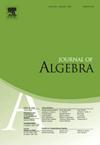Elementary construction of canonical bases, foldings, and piecewise linear bijections
IF 0.8
2区 数学
Q2 MATHEMATICS
引用次数: 0
Abstract
Let be the negative half of a quantum group of finite type. We construct the canonical basis of by applying the folding theory of quantum groups and piecewise linear parametrization of canonical basis. Our construction is elementary, in the sense that we don't appeal to Lusztig's geometric theory of canonical bases, nor to Kashiwara's theory of crystal bases.
正则基、折叠和分段线性双射的初等构造
设Uq−为有限型量子群的负一半。利用量子群的折叠理论和正则基的分段线性参数化构造了Uq -的正则基。我们的构造是基本的,在某种意义上,我们没有诉诸于吕兹提格的正则基几何理论,也没有诉诸于柏原的晶体基理论。
本文章由计算机程序翻译,如有差异,请以英文原文为准。
求助全文
约1分钟内获得全文
求助全文
来源期刊

Journal of Algebra
数学-数学
CiteScore
1.50
自引率
22.20%
发文量
414
审稿时长
2-4 weeks
期刊介绍:
The Journal of Algebra is a leading international journal and publishes papers that demonstrate high quality research results in algebra and related computational aspects. Only the very best and most interesting papers are to be considered for publication in the journal. With this in mind, it is important that the contribution offer a substantial result that will have a lasting effect upon the field. The journal also seeks work that presents innovative techniques that offer promising results for future research.
 求助内容:
求助内容: 应助结果提醒方式:
应助结果提醒方式:


